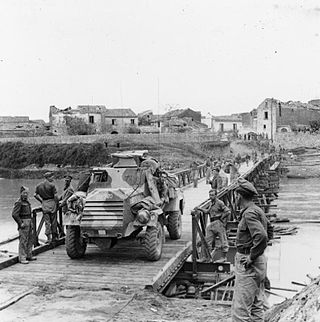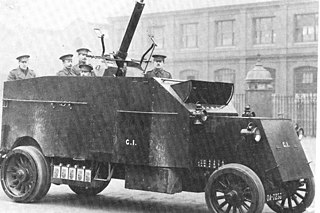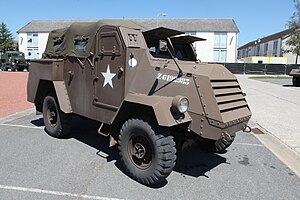
An armoured fighting vehicle or armored fighting vehicle (AFV) is an armed combat vehicle protected by armour, generally combining operational mobility with offensive and defensive capabilities. AFVs can be wheeled or tracked. Examples of AFVs are tanks, armoured cars, assault guns, self-propelled artilleries, infantry fighting vehicles (IFV), and armoured personnel carriers (APC).

A half-track is a civilian or military vehicle with regular wheels at the front for steering and continuous tracks at the back to propel the vehicle and carry most of the load. The purpose of this combination is to produce a vehicle with the cross-country capabilities of a tank and the handling of a wheeled vehicle.

The Combat Vehicle Reconnaissance (Tracked), abbreviated CVR(T), is a family of armoured fighting vehicles (AFVs) developed in the 1960s and is in service with the British Army and others throughout the world. They are small, highly mobile, air-transportable armoured vehicles, originally designed to replace the Alvis Saladin armoured car.

The FV432 is the armoured personnel carrier variant in the British Army's FV430 series of armoured fighting vehicles. Since its introduction in the 1960s, it has been the most common variant, being used for transporting infantry on the battlefield. At its peak in the 1980s, almost 2,500 vehicles were in use.

The FV603 Saracen is a six-wheeled armoured personnel carrier designed and produced by Alvis from 1952 to 1976. It has been used by a variety of operators around the world and is still in use in secondary roles in some countries. The Saracen became a recognisable vehicle as a result of its part in Operation Banner in Northern Ireland as well as for its role in the South African government's enforcement of apartheid.

The Ordnance QF 2-pounder, or simply "2 pounder gun", was a 40 mm (1.575 in) British anti-tank gun and vehicle-mounted gun employed in the Second World War.

A Kangaroo was a Canadian armoured personnel carrier (APC) during the Second World War which was created by converting a tank chassis. Kangaroos were created as an expedient measure "in the field" by the Canadian Army, and were so successful that they were used by other Commonwealth forces, including the British Army.

The M3 Scout Car was an American-produced armored car. The original M3 Scout Car was produced in limited numbers, while the improved M3A1 Scout Car saw wide service during World War II and after.

A Kégresse track is a kind of rubber or canvas continuous track which uses a flexible belt rather than interlocking metal segments. It can be fitted to a conventional car or truck to turn it into a half-track, suitable for use over rough or soft ground. Conventional front wheels and steering are used, although skis may also be fitted. A snowmobile is a smaller ski-only type.

An artillery tractor, also referred to as a gun tractor, is a specialized heavy-duty form of tractor unit used to tow artillery pieces of varying weights and calibres. It may be wheeled, tracked, or half-tracked.

The Cadillac Gage Commando, frequently denoted as the M706 in U.S. military service, is an American armored car designed to be amphibious. It was engineered by Cadillac Gage specifically for the United States Military Police Corps during the Vietnam War as an armed convoy escort vehicle. The Commando was one of the first vehicles to combine the traditionally separate roles of an armored personnel carrier and a conventional armored car, much like the Soviet BTR-40. Its notable height, amphibious capability, and waterproofed engine allowed American crews to fight effectively in the jungles of Vietnam by observing their opponents over thick vegetation and fording the country's deep rivers.

The Otter Light Reconnaissance Car (known officially by the British as Car, Light Reconnaissance, Canadian GM was a light armoured car produced in Canada during the Second World War for British and Commonwealth forces.
A huge number of M113 Armored Personnel Carrier variants have been created, ranging from infantry carriers to nuclear missile carriers. The M113 armored personnel carrier has become one of the most prolific armored vehicles of the second half of the 20th century, and continues to serve with armies around the world in many roles.
The British Army made extensive use of a variety of combat vehicles during the Second World War. This article is a summary of those vehicles.

The D-442 FUG and D-944 PSZH are the results of Hungarian domestic development of relatively cheap amphibious armoured scout car and armored personnel carrier series. FUG and PSZH were exported with limited success, thus it is also known under its Czechoslovak designation OT-65.

Canadian Military Pattern (CMP) trucks were mutually coherent ranges of military trucks, made in large numbers, in several classes and numerous versions, by Canada's branches of the U.S. 'Big Three' auto-makers during World War II, compliant to British Army specifications, primarily intended for use in the armies of the British Commonwealth allies, but also serving in other units of the British Empire.

Throughout its history, the Irish Army has used a number of armoured fighting vehicles.

The Pierce-Arrow armoured AA lorry was a self-propelled anti-aircraft carrier mounting a QF 2-pounder AA "pom-pom" gun, it was used by the Royal Marine Artillery during the First World War.
















